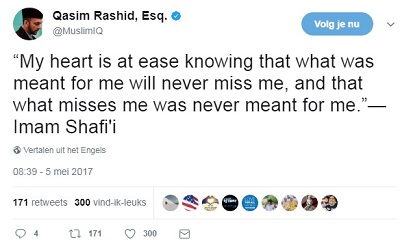Fact checking Qasim Rashid
on Female Circumcision
As we came across this blog of a popular Muslim apologist it struck us once again how uninformed the West is on the subject of Islam despite it being at the top of public debate for many years. One would think that by now prominent Muslims such as Qasim Rashid wouldn’t dare feed us such a biased and unscholarly article, echoing the clichéd mantra “nothing to do with Islam”. Nothing ever seems to have anything to do with Islam as far as people like Rashid are concerned. At least whenever something is found to be negative by the West. Slavery? Never a thing in Islam. Child marriage? Yes, for the prophet perhaps but certainly not for regular Muslims. Offensive warfare against non-Muslims? Never heard of it. And while all these topics have been accepted within mainstream Sunni Islam since the beginning, Westerners are content with hearing any modern Muslim’s denial, without ever researching the issues for themselves.
It’s no different when it comes to Female Genital Mutilation (FGM) or female circumcision. While fully embraced by all four madhabs (schools of thought) within Sunni Islam for centuries on end, suddenly people like Rashid are clinging on to modern interpretations which don’t go back more than fifty years. Efforts to condemn FGM are welcome, of course, since we should by all means exterminate the practice as soon as possible. But the way forward is not found in denying the root of a problem. That’s why there’s an obstacle, when a spokesperson for Islam tries to whitewash Islam’s current and past marriage to FGM, pretending it was never part of any serious view of the religion.
It is quite the opposite as we will be demonstrating in this blog. For any honest student of Islam it becomes clear that female circumcision has been considered permissible for ages by all four madhabs. In fact one of them deems the practice just as compulsory as the well-known circumcision of boys. We will start by highlighting a few of Qasim Rashid’s points in the mentioned article and provide them with our commentary. We know mister Rashid is an Ahmediya Muslim but in his article he seems to draw from theological sources also accepted by the Sunnis.
Only one hadith?
In his article Rashid immediately draws as much attention as possible to one particular hadith which proponents sometimes mention. This hadith is indeed a weak narration according to some renowned scholars. Then, by continuing to dwell on this one hadith, Rashid suggests to his readers that nothing else is ever brought forth by both proponents of the practice and critics of islam. Soon enough he has pushed the strawman argument enough to be able to write that: “Extremists and Islamophobes alike ignore the Qur’an altogether and focus only on the single Abu Dawud Hadith”. However, this is not true at all as we’ll soon find out.
If we visit islamqa.info and check the fatwas on the issue of female circumcision, we see that the very people Rashid presumably refers to as extremists base their theology on hadiths other than the one in Sunan Abu Dawud. In fact, the irony is that they specifically mention that this hadith is not what they base their theology on:
“The fact that circumcision for women is prescribed in Islam is confirmed by the ahaadeeth quoted above, not by this disputed hadeeth.” [1]
The same legitimacy can be found on Sunnah.org.[2]
So, Rashid says the extremists only have one weak hadith while they themselves provide us with several other undisputed narrations. At the very least Rashid’s statement was uneducated but we think it may have been meant to mislead. We say this because a man of his education must know about the well-known reasons for accepting FGM and the proof scholars have provided numerous times.
You may wonder which hadiths were “quoted above” in the mentioned fatwa. The narrations are both from collections that are considered authentic (sahih). The first, from Sahih Bukhari, mentions Muhammad saying the fitrah (human nature) of people is five things, one of them being circumcision. Because no gender is specified, most scholars have taken this as a sign that it refers to both.[3] The second hadith, from Sahih Muslim, mentions that the ritual washing (ghusl) is obligatory after the two circumcised parts of a husband and wife have touched. [4] This latter source can be corroborated by yet another hadith, not mentioned in the fatwas above, in which Aisha refers to this narration and adds that she and Muhammad performed the ritual washing after their circumcised parts had touched.
Qasim Rashid failed to mention any of these narrations, while popular “extremist” websites refer to them openly. It seems Rashid has grossly misrepresented the view of his opponents. This sloppy work of apologetics in all likelihood does not help the Islamic community in the long run. Honesty remains the best policy. If people find out that a spokesperson like Qasim Rashid continuously provided them with only half the story, it may do more damage to the already dubious reputation Muslims scholars have with regards to their statements before Western audiences. We can understand a man’s desire for Islam to be free from FGM, but this must never get in the way of the scholarly task to be honest about all the evidence at hand.
Irrelevant Quran reference
Let’s continue with Rashid’s article. He mentions that one particular verse in the Quran refutes the idea that FGM could ever be allowed in Islam. But upon visiting the verse it becomes painfully obvious that it has absolutely nothing to do with the subject. One cannot take back the money that was once given to a wife after divorcing her, it says in Surah 4 verse 20. Well that’s wonderful Rashid, but what does that have to do with not being allowed to cut into a girl’s genitalia?
Cultural or religious?
Then Rashid mentions that FGM has been practiced by Muslims, Jews and Christians, presumably in an attempt to generalize the tradition. This way we can all buy into the idea that it was never anything more than a cultural phenomenon, left over from the ancient times of the Pharaohs. But the fact is that female circumcision, though indeed merely a cultural and rare phenomenon for Jews and Christians, and impossible to legitimize through any exegeses of their respective scriptures, is unfortunately religiously inspired in the case of Islam. It is clear that the scriptures of Islam are not silent on the matter and, perhaps more importantly, the most notable scholars have embraced this practice from day one. This results in a full-blown acceptance between all four of the major Sunni schools of thought, only differing on whether it is obligatory (wadjib) or merely a recommended and honorable practice (Sunnah).
Mainstream Islam and FGM
We’ve already seen that the so called extremists base their ideas on authentic hadiths. Whether we agree with them is a different – and for our discussion irrelevant – issue. After proving that people like Qasim Rashid seem to misrepresent their opponents positions deliberately, the only other thing relevant to our topic is answering the question as to whether the practice has only been embraced by extremists or is accepted by mainstream scholars of Islam.
 Al-Misri
Al-Misri
The Reliance of the Traveler is a classical manual representing the Shafi’i school of thought within Sunni Islam. We know that Qasim Rashid at least admires imam Al-Shafi’i, whose name was given to that particular school of thought, since he proudly quoted him on Twitter just two months ago. [5] The mentioned manual was written by the renowned sheikh Al-Misri in the fourteenth century. His work is still considered essential for any student of Islam. What does it say about female circumcision?
Let’s find out:
“e4.3 Circumcision is obligatory (O: for both men and women. For men it consists of removing the prepuce from the penis, and for women, removing the prepuce (Ar. bazr) of the clitoris (n: not the clitoris itself, as some mistakenly assert). (A: Hanbalis hold that circumcision of women is not obligatory but sunna, while Hanafis consider it a mere courtesy to the husband.” [6]
This book can be bought everywhere online, and yet Qasim Rashid said that “the vast majority of the Muslim world condemns FGM, and always has throughout history”. What a strange thing to say when this famous medieval manual on Sharia is found in every major bookstore. We also know that all four madhabs have embraced FGM, not just the Shafi’i’s. Now of course they would never call it Female Genital Mutilation because, like circumcising boys, they do not consider it to be a mutilation. Regardless, at least one of the four madhabs consider female circumcision obligatory. Most scholars within the other schools recommend it as a righteous thing to do.
Al-Nawawi
Another famous Shafi’i scholar from the past, known as Imam al-Nawawi, wrote about his the schools of thought one century prior to Al-Misri. In his commentary on Sahih Muslim he provides the reader with the following statements:
“Circumcision is obligatory (wadjib) according to al-Shafi’i and many of the doctors, sunna according to Malik and the majority of them. It is further, according to al-Shafi’i, equally obligatory for males and females. […] As regards to females, it is obligatory to cut off a small part of the skin in the highest part of the genitals.” [7]
Fath al Bari
Fath al Bari is the most notable commentary on Sahih Bukhari. When its writer, Ibn Hajar, discusses a hadith on ritual washing which doesn’t mention the touching circumcised parts of the male and female, he makes a reference to the hadith that does, saying:
“What is meant by the dual form in the phrase ’the two circumcised parts’ is the circumcised genitals of the man and the woman respectively. Male circumcision (khatn) is the removal of the skin of the head or glans of the penis. Female circumcision (khifad, khafd) is the removal of a tiny piece of skin in the uppermost part of her genitals which resembles the crest of a rooster, and between it and the entrance of the penis there is a thin membrane.” [8]
Different types of FGM: only one is Islamic
Just like Al-Misri, Ibn Hajar states that the Islamic female circumcision is the removal of a tiny piece of (fore)skin. It is only fair to note that the types of FGM often found in countries like Egypt and Somalia are an exaggeration of the practice as it was meant to be in mainstream Islam. Cutting off the clitoris is widely viewed as an un-Islamic version of female circumcision. However, this does not exempt Islam from any blame, since cutting in the genital area of young girls should not be a religious doctrine to begin with. Besides, their motivation for doing so is Islam, even though they may be wrong in their particular form of execution. Medical professionals generally distinguish between three or four types of FGM, type I being the so called ‘Sunna’ type which refers to the one recommended in Islamic jurisprudence. The World Health Organisation (WHO) also uses this name and condemns all types of female circumcision for it’s health risks.
Ahmad Ibn Hanbal
We’ll provide you with another quote, from a hadith which was collected by another foundational Islamic scholar. This time the work of the man whose name was given to the Hanbali school of thought is cited:
“Abu al- Malih ibn `Usama’s father relates that the Prophet said: “Circumcision is a law for men and a preservation of honor for women.” [9]
It is needless to say that Rashid’s comments lack any historical balance since he focuses on post-modern Islam while the religion he adheres to has a vast history on the matter of female circumcision. One he dismissed altogether without ever substantiating his denial of its existence.
Not in the Quran
Qasim Rashid further states that female circumcision is not mentioned once in the Quran. This argument is disappointing, since we’ve heard it over and over again by both Muslim apologists and Westerners who seek to appease them. Our shortest refutation of that argument is: “Nor is the circumcision of boys found in the Quran.” The smokescreen quickly vaporizes when you point out this fact, because it brings us back to the hadith collections where so many Islamic doctrines stem from. And as we’ve already seen, there are at least two hadiths the mainstream jurists of Islam have always used to legitimize female circumcision, none of which Rashid ever allowed his audience to learn about.
Pre-Islamic
Now it is true that FGM predates Islam. But so do prayer and fasting. The crucial factor is that Islamic scholars have, based on their theological sources, embraced the practice since the very beginning. The same cannot be said for Jews and Christians. This is the religious component people often deny. At this point we would like to note that those Christians in Africa who do join Muslims in the horrific practice are mostly found among Christian minorities in Muslim countries. At the same time most Christian nations worldwide which encounter FGM within their borders generally, though not always, experience FGM numbers which can be accounted for by Muslim minorities residing there. It is obvious that assimilation plays a crucial role, as people often think of their traditions as cultural, while ignorant of the fact that they are rooted in the predominant religion of their country as it was once installed by their ancestors. A comparison can be made to Muslims in the West partaking in the celebration of Christmas and Easter, or their adherence to the Christian prescription of monogamy, including the belief that polygamy should be outlawed. These are practices which Westerners themselves often regard as cultural and no longer recognize for their religious roots. And in those predominantly Christian countries where FGM is not only practiced by the (often large) Muslim majority but also by the Christians themselves, reasons can be found in their geographical position as they are always closed in by Muslim countries on several sides. Once the far south of Africa is reached, the practice which is often mistakenly viewed as “typically African” immediately disappears off the radar. Indonesia, for instance, has a widespread tradition of FGM which has everything to do with the dominance of the Shafi’i school of thought within its borders. FGM is therefore not a Salafi or extremist practice. It mostly depends on which Islamic school of thought a country or mosque follows and the cultural willingness to accept this as part of daily life.
Summary
Based on two hadiths Rashid failed to mention; the rulings of the madhabs throughout the ages; the terribly transparent smokescreen concerning an unrelated ayah; and Rashid’s alluding to Christians and Jews, we must dismiss his claims. On the contrary: the fact is that FGM always was a part of Islam and still is today. That’s why it is not merely practiced in Africa, as many people claim, but also in places like Indonesia which is the largest Muslim country. This is of course due to Shafi’i influence, which has shaped Indonesia’s Islam from the moment it was introduced to it. We agree with Rashid that it is a practice that should be banned, today rather than tomorrow. But to misrepresent Islam’s history, as is done so often in the case of slavery and Jihad, must never be accepted as a mere means to an end. If Islam has embraced the practice throughout history, be honest about it and call yourself a reformer rather than an adherent of the one true form of Islam as it was understood for fourteen centuries.
References
[1] Islamqa.info; fatwa no. 60314; link
[2] http://www.sunnah.org/msaec/articles/circumci.htm
[3] Sahih Bukhari, book, 72, hadith 777; link
[4] Sahih Muslim, book, 3, hadith 684; link
[5] https://twitter.com/MuslimIQ/status/860519308304187393
[6] Ahmad Ibn Naqib Al-Misri, Umdat as-Salik wa ‘Uddat an-Nasik, translation: Reliance of the Traveler, translation by Sheik Nuh Ha Mim Keller, section e.4.3
[7] Wensinck, A.J.; The Encyclopaedia of Islam, Volume 5, page 20 (1979 edition)
[8] Fath al Bari 1:520, chapter 28, hadith 291
[9] Musnad Ahmad Ibn Hanbal 5:75




















![Shabir Ally’s mathematical miracles debunked [HD]](https://deovolentenl.nl/wp-content/uploads/2015/11/shabir-english-400x284.jpg)












![Deo Volente NL in gesprek met Maiwand al Afghani [deel 1]](https://deovolentenl.nl/wp-content/uploads/2015/07/mai-2.jpg)
![Deo Volente NL in gesprek met Maiwand al Afghani [deel 2]](https://deovolentenl.nl/wp-content/uploads/2015/07/mai-1.jpg)
![Deo Volente NL in gesprek met Maiwand al Afghani [deel 3]](https://deovolentenl.nl/wp-content/uploads/2015/07/mai-5.jpg)
![Deo Volente NL in gesprek met Maiwand al Afghani [deel 4]](https://deovolentenl.nl/wp-content/uploads/2015/07/mai-3.jpg)